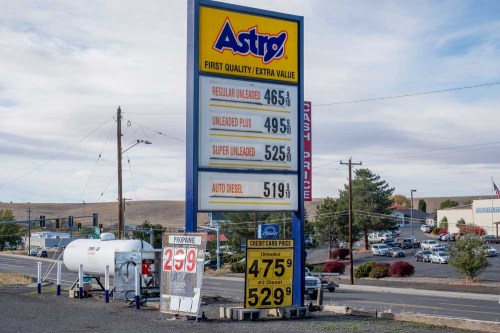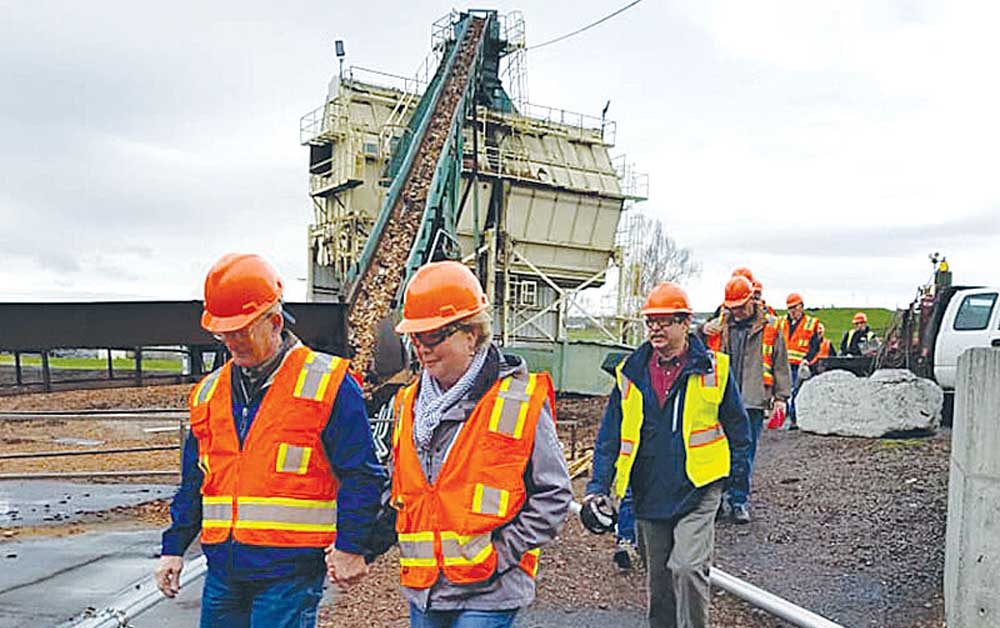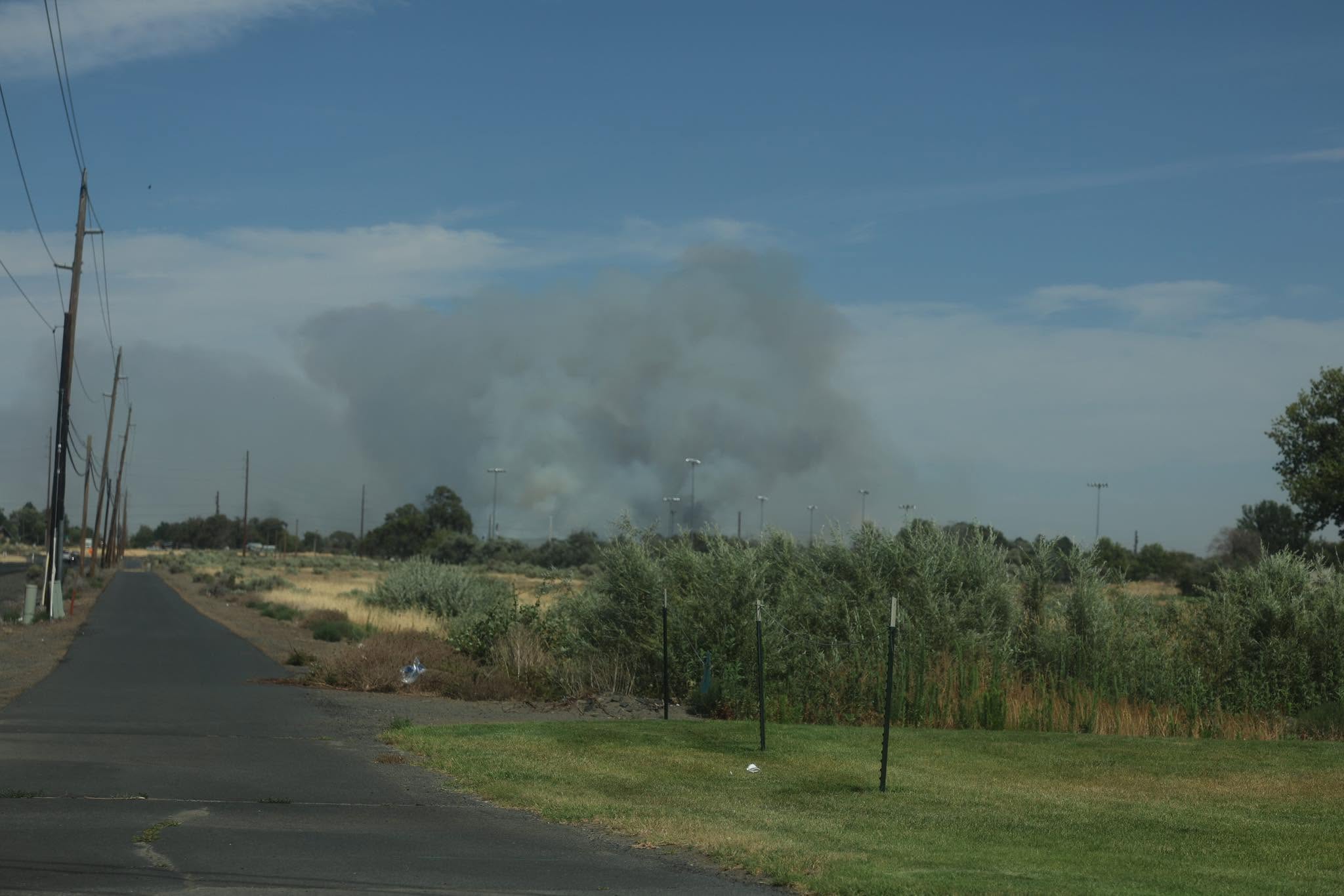Local diesel prices remain even higher than in Oregon and U.S., amid low supply and inelastic demand
Published 10:00 am Wednesday, November 9, 2022

- Diesel price Monday, Nov. 7, 2022, at the Astro Station at 1302 Southgate, Pendleton, is lower than Pendleton's average, according to AAA Oregon.
PENDLETON — Regular gas price averaged $4.97 per gallon in Pendleton on Monday, Nov. 7, up from $3.79 a year previously, according to the AAA.
However, this average price was down from $5.08 a week earlier and $5.62 a month earlier. A record high of $5.64 was set on Oct. 9.
Diesel by contrast has not pulled back as much. Its price in Pendleton averaged $5.65 per gallon Nov. 7. Its year-ago average was $3.75. A week and month earlier, its averages were $5.71 and $5.74. Pendleton’s record-high diesel price average of $6.44 was set July 3.
Diesel is off its local high by 79 cents, while regular gas has pulled back 67 cents. However, diesel still is up $1.90 from its average price a year ago, while regular gas by just $1.18.
Worries over Russian oil production cuts have put upward pressure on pump prices, sending the national average higher, Marie Dodds, AAA director of public affairs said. But Oregon and other West Coast states are bucking the trend, with gas prices continuing to decline.
For the week, the national average for regular adds a nickel to $3.80 a gallon. The Oregon average falls 11 cents to $4.83. This is the largest weekly drop for a state in the nation, Dodds said.
National regular gas average was $3.80 on Nov. 7, and $4.84 in Oregon. Diesel averaged $5.34 in the U.S. and $5.56 in Oregon. Good international and national reasons explain relatively lower gas than diesel prices.
After Hawaii and California, Oregon and Washington have the highest average state diesel prices in AAA data. Diesel averaged $5.70 in Washington, $6.06 in Hawaii and $6.29 in California on Monday.
Diesel consumers also baffled by the fuel’s staying up while gasoline prices have softened.
“I have no idea why,” said John Robertson of Pendleton, retired from the U.S. Forest Service, while filling up his Ford F-350 Power Stroke pickup on Nov. 7. “I wish it wasn’t higher than gas, especially with a diesel pickup.”
Robertson is moving to Long Beach, Washington. Wind and rain lowered fuel mileage on his trip with a fully loaded trailer Friday, so he had to refuel in Kalama, Washington, rather than Astoria.
“I’d like to know why fuel is more expensive on the freeway than in Pendleton and Astoria,” Robertson said. “It seems to defy the law of supply and demand.”
While California and Washington diesel taxes are higher than Oregon’s, some other states, such as Pennsylvania, have even higher rates.
Some energy specialists think they have a hint as to explanations for gas and diesel price differences.
While gasoline prices have started to hit the brakes nationally, it has been full steam ahead for diesel, a Nov. 7 Marketwatch Commodities Corner article by Myra P. Saefong said. U.S. supplies of the fuel used in freight transportation and agriculture dropped to their lowest on record for this time of year.
That has kept U.S. diesel prices high at the pump, with a gain of more than 8% in October, even as gasoline saw little change to prices this past month, based on data from GasBuddy.
Shortages of diesel fuel around the globe and in the U.S. spurred the latest price advance, Brian Milne, product manager, editor and analyst at agricultural data company DTN, has reported, calling the U.S. diesel fuel inventory “extraordinarily low,” with supplies in the Northeast “critically low.” Competition in winter with heating oil in the Northeast could hike prices.
Domestic supplies of distillates, which include diesel and heating oil, as of the week ended on Oct. 28 were 19% below the five-year average. That was the lowest level on record for this time of year, based on data going back to 1982, according to the Energy Information Administration.
Refineries have generally reduced capacity as a result of policy preferences for biofuels. Power demand is a driver for distillates because world supply is “super tight” on liquefied natural gas, according to Craig Golinowski, managing partner at Carbon Infrastructure Partners.
U.S. retail gasoline prices, meanwhile, have dropped nearly 25% from their record high in June, while U.S. crude-oil prices have fallen around 25% from their year-to-date peak.
”The world finds itself with a reasonable supply of crude oil and gasoline, but some distinct problems with diesel, heating oil, jet fuel and kerosene,” Tom Kloza, global head of energy analysis at the Oil Price Information Service, said.
Of those four, diesel was the most critical. He estimated U.S. distillate supply at roughly just 19 days.
”Diesel is in a multidecade global inventory shortage,” Joe DeLaura, senior energy strategist and executive director at Rabobank, said.
Diesel inventories at three major storage hubs excluding China, i.e. the U.S., Europe’s Amsterdam-Rotterdam-Antwerp and Singapore, were at 132 million barrels, DeLaura said, compared with the 10-year average of 174 million.
Supply has been reduced, as the U.S. has shed refining capacity, DeLaura said. Demand, however, has been relatively strong and “inelastic,” given that even in a recession, people will still buy food and get packages delivered by the diesel economy.
”A price will be paid for the lack of investment in new drilling and new refineries,” Salem Abraham, president of Abraham Trading, said.
Given high oil, natural gas and diesel prices in a recession at the end of a pandemic, then the situation could be worse in 12 to 24 months, when demand might increase.









